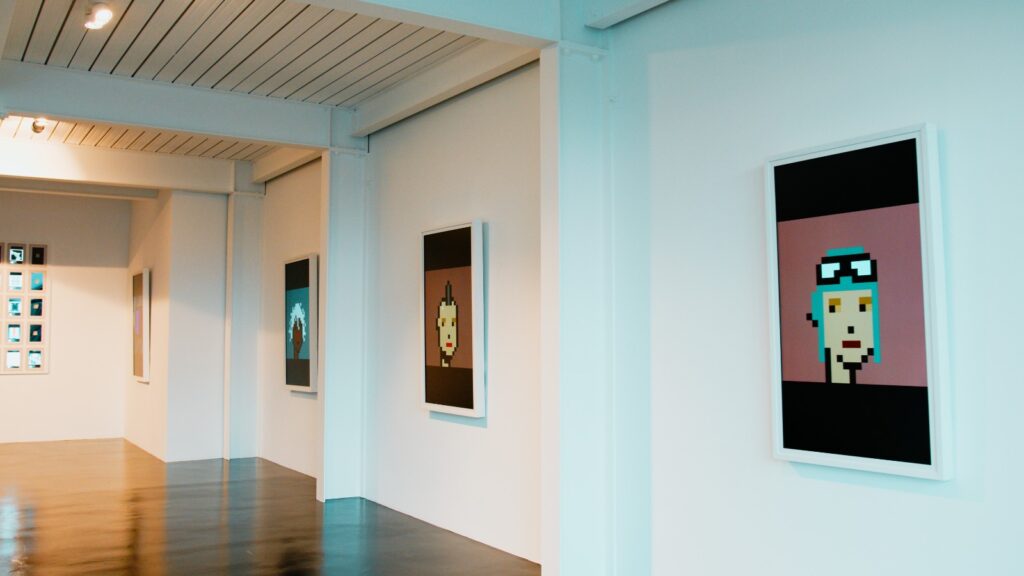NFT art is a safe haven in times of crisis and potentially offers a return. NFTs are worthless. Investing in NFTs is dangerous. The NFT trend is over… So many preconceived ideas about NFTs, an acronym for Non-Fungible Tokens, are circulating. For several months, the web has been abuzz with talk of this new “asset class” based on blockchain technology. But what is it in concrete terms? Romain Bagnoud and Marco Vidulli, two Swiss experts opening the first art gallery combining physical and digital works of art on February 1st , give us some explanations.
First, are NFTs investments for return or pleasure?
It all depends on the will and vision of the person investing. It is essential to distinguish between “utility NFT” and “art NFT”.
Utility NFTs promise “IRL” (in real life) benefits, yield solutions, and more. These NFTs are usually collections/clubs of 10’000 units.
Art NFTs have no purpose other than to be collected, traded, and appreciated for their artistic quality. Much more exclusive than utility NFTs, they are aimed at a collecting public that acts in a similar way to “traditional” collectors.
Like traditional art, NFT art is a safe haven in times of crisis and potentially offers a higher resale yield than NFT utilities, although less liquid.
Are you talking about liquidity? What should you look for when investing?
From the investor’s point of view, liquidity is indeed an important factor. So is the potential return and the timing (hype).
However, for the art lover, the important thing is to select his NFTs according to his taste!

For the uninitiated, how would you define investing in NFTs?
Difficult and stormy! However, following certain rules, can quickly become a pleasure. Even today, few people fully understand the potential of NFT technology and its various uses.
Those interested should go to Twitter first to learn about and find artists and projects. After that, most of the secondary trading activity is done on Opensea. This is a site where anyone can create and sell NFTs. This facility opens the door to all sorts of abuses and poses apparent problems for intellectual property. These reasons are the main obstacles to the integration (“onboarding”) of people who are not already holders of cryptocurrencies. The majority of NFT listings are in Ethereum (ETH), a volatile crypto.
We must not forget the numerous “fake news” in this field!
What advice would you give?
You need to know and understand blockchain, ETH, and NFT technologies. Then, be well-informed before buying. Or even better, get a professional to accompany you. And above all, select only quality assets and choose only platforms that do curation work upstream.
To support NFT fans, you decided to launch the Demerittes project. Tell us about it…
Our project wants to link the virtual world to the real one through a permanent physical gallery in Geneva in order to offer a new customer experience that combines physical art and NFT.
Demerittes is also a curated marketplace. The latter offers the highest level of curation, the assurance of having access to a selection of first-class NFT (unique digital art, generative art, physical art links to NFT, asset-backed NFT, 10k club).
We are also on a mission to facilitate the education of the public and traditional artists about this technology and thus democratize the investment in NFT. We want to create direct connections between artists, brands, and NFT enthusiasts, especially through the integration of new artists.
By the way, how do you select your artists and partners?
We have a strict selection process for the artists and brands we work with. The level of execution and originality of the work as well as any distinctive elements or trademarks are paramount.
Concerning the artists known as “Web3, digital”, we clearly have a preference for the artists known as “OG”, i.e. who were there before the “NFT hype”… and who will remain even if this last one were to disappear. The fact that the digital artist is there during the “bear market” period, especially with a presence on Twitter, and that he continues to develop his art and bring added value to the ecosystem is a guarantee of credibility and seriousness in our eyes.
As for the so-called traditional artists, the person’s work must resonate with our values. Furthermore, we want to directly connect with the artist on both a human and artistic level. For partners, brands and foundations, it is imperative that we share the same values and visions.




